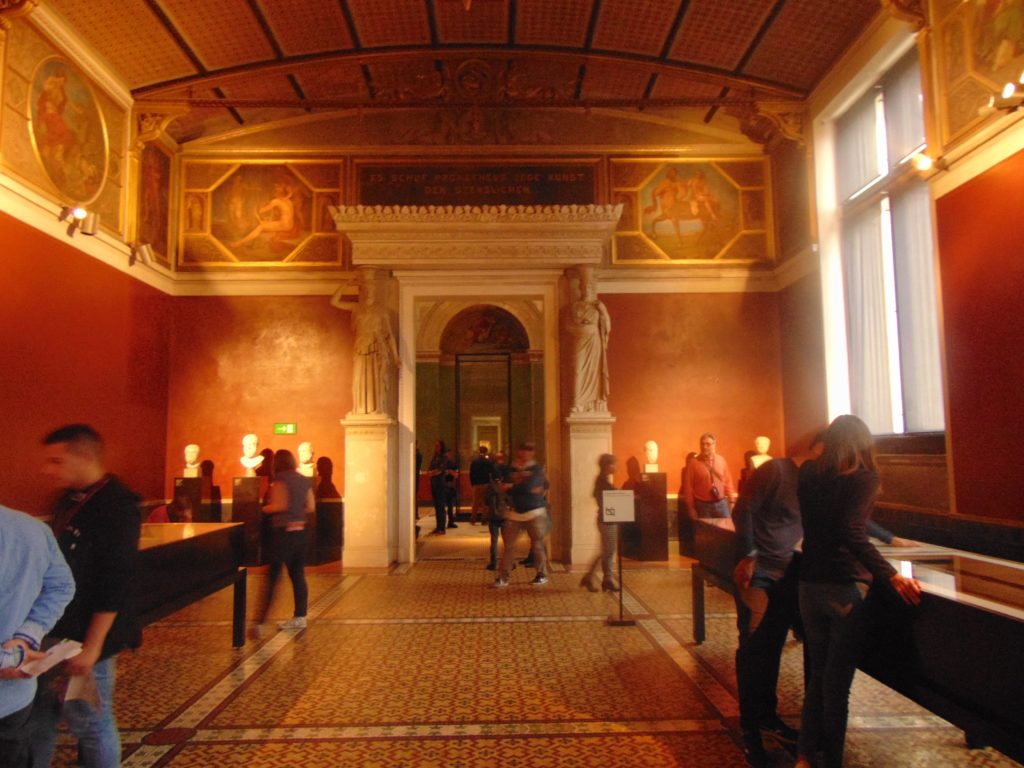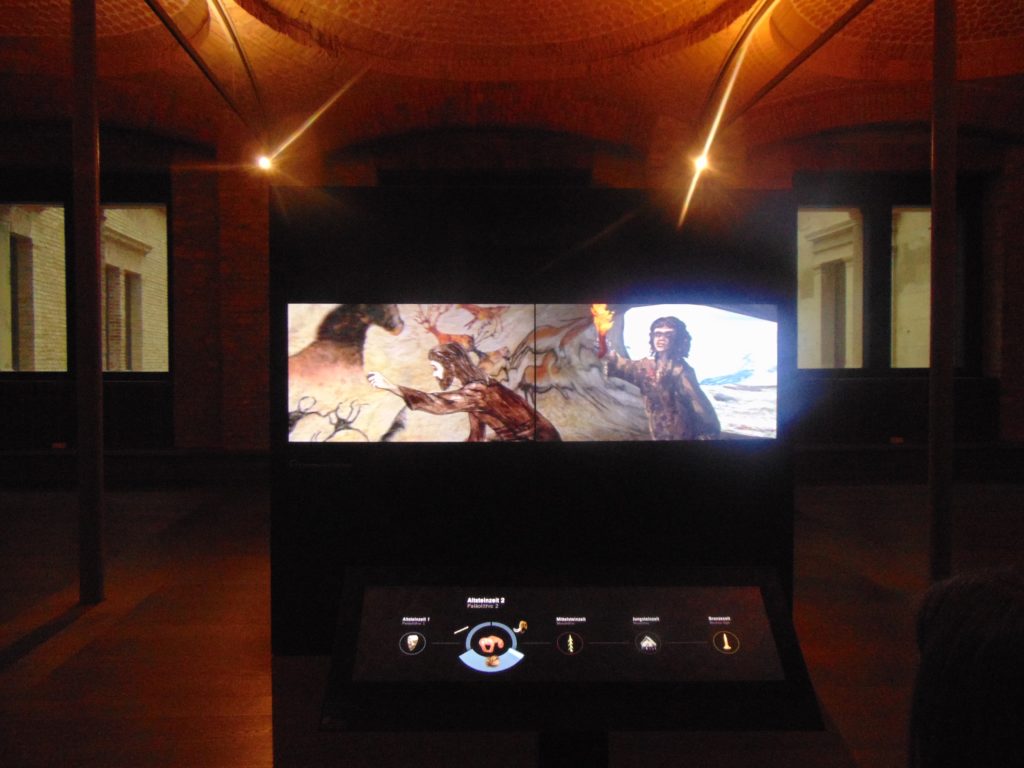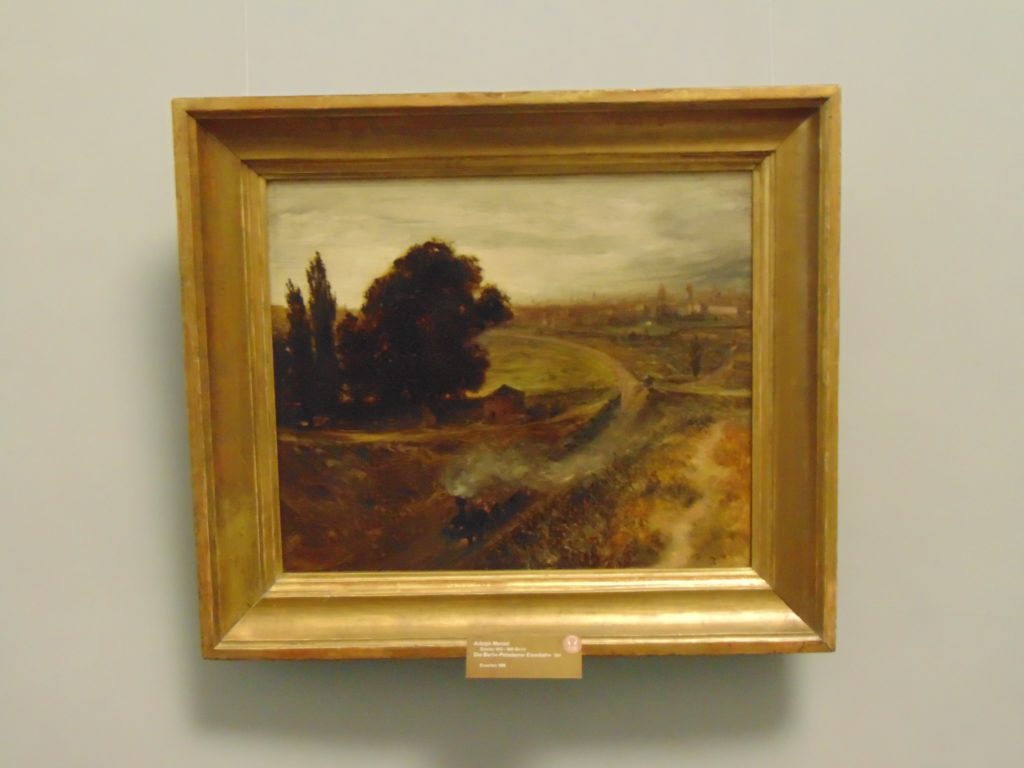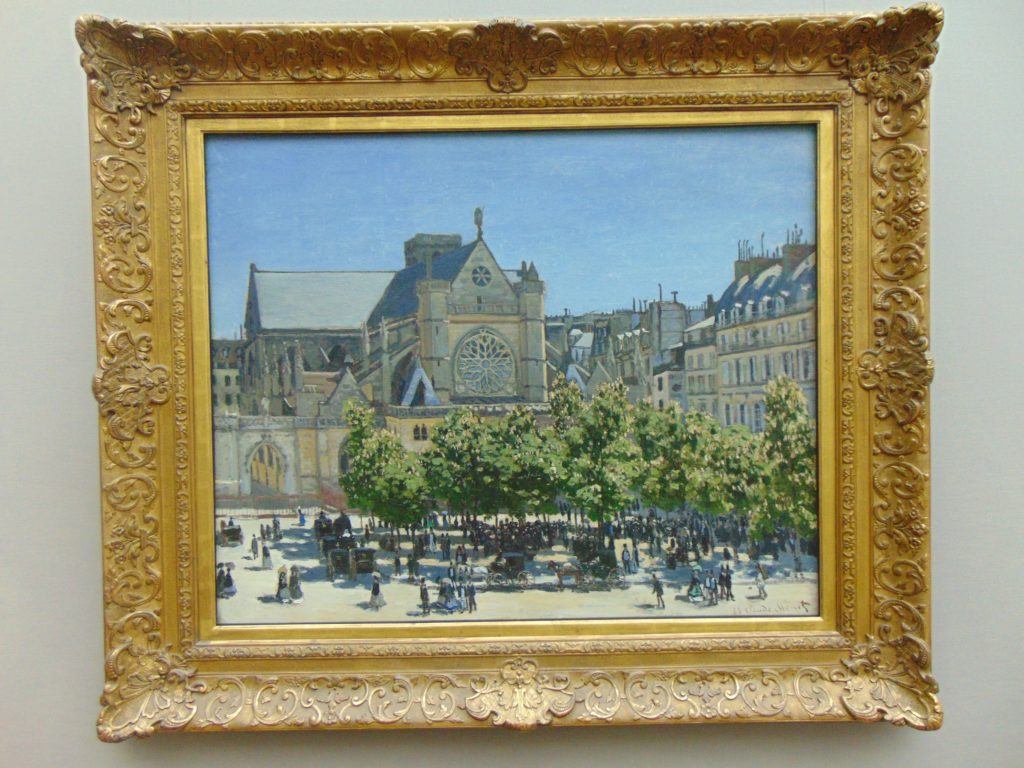
But what exactly are modern times and, if we are already in them, when did they begin?
Perhaps you could fix the precise date of the birth of modern times every time something is no longer as it was. Following this line of reasoning, history would be full of multiple modern times, from pre-history up through today. You could trace a line of civilization as long as you wanted and scatter points of rupture with the past throughout it and to whoever still believed that history was the study of ancient things immediately illustrate that, no, it is nothing other than the occurrence of the latest thing, history always having the natural sagacity to position itself precisely there in front of the right turning point and from there emerging into the present. The newest generations, all those people living in the virtual world, know exactly how such things work.
Let us take, for example, Room 211, the so-called Ancient Library or Library of Niobe, on the second floor of the Neues Museum. The large horizontal display cases contain trays which are conveniently controlled by button and which contain examples from the colossal collection of 45,000 up-to-4000-year-old documents held here in Berlin, the representatives of one of the most important collections in the world. It is mainly consists of Egyptian writings on papyrus but also on fabrics, paper, plaster cast, tablets of clay, wax, wood, leather…The texts are mostly written in hieroglyphic script, the formal writing system of Egypt for around 3,000 years, but not exclusively. Some are also written in hieratic script, the administrative language made up mostly of abbreviations, as well as in Ethiopian, Syrian, the demotic slang spoken by the common people between the 8th and the 4th centuries BC, Aramaic, and even Greek thanks to Alexander the Great’s conquest in 332 BC. And then there is Latin thanks to the Romans, and Coptic too, that language from the late Egyptian period made up of a mixture of Greek and demotic letters, and, last but not least, Arabic, the official language of Egypt up until today thanks to the Arabic conquest in the 8th century AD…
If historians agree in marking the beginning of history with the discovery of writing, then here, in this beautiful 19th century hall with its movable trays at our fingertips, we are taking part in that modern step that brought humanity from savage pre-history into serious history and find ourselves standing before a monumental turning point in the world.
The most ancient writings in the world, conserved thanks to the dry climate of Egypt and venerated here like relics, are precious testimonies to the almost four millennia of human activity and thought regarding medicine, magic, mathematics and astronomy, philosophy, language and philology, religion and literature, rights and commerce…These texts are so delicate that they may not even be photographed, but a great team of restorers, Egyptologists, Orientalists and information experts are at the moment digitizing the entire collection in order to conserve it forever, whatever that term might mean, and to allow us to read it, provided that we are really able understand anything at all, in the comfort of our own homes.
On the southern portal of the library we find, quoting Sophocles, the majestic words: “There are many wonders in the world, but none are greater than man.” And the frieze above the northern portal responds in a dignified manner with Aeschylus: “All arts come from Prometheus to mankind!” Prometheus, the Titan who stole fire from the gods in order to give it to human beings, a symbol of freedom of thought and of human ambition toward consciousness who was therefore punished by Zeus with the atrocious form of torture of being bound to a rock…and having an eagle eat his liver by day…and having that liver grow back at night…only to have the eagle arrive first thing in the morning to tear apart his bowels once more and devour his liver…a literally gut-wrenching myth, but one that at least has a happy ending. For, in the end, the courage of rebelling against the rules and the status quo pays off because Hercules arrives and, with Zeus’ permission, undoes poor Prometheus. This is a great piece of news, for it signifies the triumph of courage, of art, of independent and free research which leads to human progress: modern times, without a doubt.
And so, if even primordial history is teeming with revolutionary fervor, then history in general will remain attractive for every generation. No more reverential awe before the ancients, no more of the annoying and dead notions for useless flights of nostalgia – history is here, it’s present, so present that it does not need to be studied, but passionately lived. Dr. Soran would probably say that not only time, but history is the “fire in which we burn” and the intuitive and revolutionary youth of today would understand him immediately.
In Room 304 of the Neues Museum, next to the rooms containing the Bronze Age horn and the Golden Hat, we often find visitors stuck to the Time Machine, a large box that is a mix between a movie theater and a television which shows a computer-enhanced film on the climactic and social evolutions of pre-history.

Hypnotized visitors can watch the Paleolithic, Mesolithic, and Neolithic Ages unfold as if they themselves were mirrored in the primitive beings they see on the screen…and, one step at a time, with the melting of the ice, these primitives become ever less hairy and are as enchanted by the magic of fire and meteorological events as today’s visitors.
There is a probably some vestigial, subliminal force in the primitives’ – as well as our own – attraction to the moving image but that’s just fine, the simulation is rather instructive.
You can watch the continual glaciations and mammoth hunts, see the first deforestations and stilt houses on the riverbanks with their pitched roofs of straw, observe animals resting peacefully in their caves, the cultivation and enclosing of fields, the first fishing nets, the rudimentary working of metals to make utensils and arms, animal skins hanging out to dry, graffiti in the caverns …
Just like that today you can even study prehistory at the Neues Museum thanks to these new and powerful means of communication – we should consider ourselves truly lucky. And those who really don’t like watching the screens can always close their eyes and abandon themselves to the new-agey soundtrack with its whistling winds, birdsong, squeaking of who knows what, barking dogs, laments that are really primitive humankind’s songs, torrents of water, drumming thud of tools splitting wood, clatter of swords, battle cries and buzzing of cicadas.
How incredible our comfortable, modern times really are!
The red headphones of the audio guide are also the utmost in modern and, throughout all five museums, tell us everything we need to know in a simple and captivating way.
The island is organized clearly and practically and the audio guides, as we said, are well-made, offering up just the right dose of ideas and comments without ever tiring the listener. These red headphones are the likeable descendants of those cold, pale telephones you used to find upon entering museums that, in an absent voice, would poison you with an avalanche of heavy and indigestible ideas and were accompanied by blurry slides that only barely managed to temper the overall terrible effect.
Today these rich museums’ sleek audio guides are calibrated for the average contemporary visitor who wants to learn a little bit and to be entertained without getting annoyed (and, above all, without getting tired) or, naturally, losing too much time because, let’s face it, there are other things to worry about in life. Two minutes per exhibit seems to be the maximum amount of attention the model visitor is able to give. And the explanations indeed do not go into any unnecessary detail: a little dash of concepts, a quick musical break (in stereo, of course), one step more and then on to the next display.
A tinkling, a brief soundtrack from the time, here you go, done. On to the next one: Tom and Dick. Whoever is interested in Harry please press the asterisk. Well now! This is indeed just how much we wanted to learn about Harry, thank you and arrivederci.
And now in front of the Ishtar Gate to the city of Babylon from the headphones comes the cavernous voice of Nebuchadnezzar II himself! We’ll never get bored, that’s for sure – and yet there’s a risk attached to our technological times. We’ll always be informed, true, but we can neglect the breath we need for reflection and, above all, to look at something with our own eyes. Today, the time one requires to establish one’s own experience – a personal and elaborate perspective of the exhibits and objects of art – has been taken away. In the end, we have become rather passive and, instead of appreciating the ease and speed with which we can find information and develop a greater awareness of things, tend to just accept this homogenized sense of culture, chasing after a little bit of everything and nothing.
But now for a rather unbiased and anachronistic, when not to say unsolicited, piece of advice: If you really want to devote some of your precious time to your own enrichment on the Museum Island of Berlin, the best thing to do is to leave all the written and spoken information behind and simply look at the pieces on display without anything in between. Don’t worry: you can give in to your curiosity to know and to anchor what you’ve seen to your consciousness at a later point in time. Primum videre, deinde philosophari. Look first, talk later. Even Aristotle knew that.
Now, this kind of approach, as should be obvious, requires time and one visit is simply not enough.
Indeed, it would be lovely if some kind of relationship between the visitor and the museum could develop, a dialogue, a history, if you will. For, in its heart, the Museum Island prefers this kind of visit and shows it by offering annual ticket holders entry at a very democratic price, just a little bit more than a ticket for a couple of regular visits.
And so, even if the road of knowledge is long and complex, in Berlin today this road is open to all and, thanks to technological development, wide and clear.
Young people up to the age of eighteen can enter all five museums for free and this is a great sign of civility indeed. Modern times on our island also mean this: democratic times and times which are open to the generations to come, farsighted times which know, like it or not, that the new will come and that it’s important to prepare for them with enthusiasm.
And yet, modern times are also intrinsically and inevitably rebellious times. In spite of the road of knowledge you’ve prepared for them, and with all the best intentions, the generations-to-come will always kick and scream and be dissatisfied, be stubborn and loud and expect the unexpected.
Consider Max Liebermann, one of the most cultivated and intelligent men Berlin has ever known. The winner of numerous painting contests, president for twelve years of the Akademie der Kunst and thereafter honorary president for many years up until the advent of Nazism, Liebermann didn’t do well at school as a boy, could not stand rules, thought only of riding horses, going rowing in summer and sledding in winter and generally was a source of great concern to his bourgeois and traditionally-minded parents. Though today we can admire numerous paintings of his in the Alte Nationalgalerie, at that time his worried father asked Max’s older brother Georg: “What do you think about the terrible news that Max wants to become a painter?” To which he responded: “It could always be worse and, in any event, he could even turn out to do something decent!”
As an adolescent Liebermann attended both academies and painting schools but always left unhappy and unsatisfied and his first paintings received only criticism. Then came his first success – though not in Germany, of course – and then another and another and, with time, he grew to be universally considered one of the greatest painters from Berlin between the 19th and 20th centuries and was nominated president of the aforementioned Akademie der Kunst. Liebermann would later say: “We are all children of our age and it is normal that the youth want to take the place of the older generations…Art is a continual becoming. No one can order it to stay still, for staying still would be equivalent to death.”
Without causing any conflict with his being a member of the Akademie, at the end of the 19th century he was also the president of the group of so-called Secessionist painters. As in every classical generational struggle, the Secessionists loved the Impressionists, those enfants terribles of recent times, then the Expressionists, they too similarly anti-academic and revolutionary. When we use the terms Impressionist or Expressionist today, the magical word revolution immediately inspires affectionate palpitations and produces great profits. Crowds are magnetized, they swarm to exhibitions and clog the doors of museums with hour-long waits. If we were finance ministers, we couldn’t do better than to organize a beautiful exhibition on Impressionism. Or better yet, one on Impressionism and Expressionism together, just like the Im-Ex exhibition held four summers ago at the Alte Nationalgalerie. And people say Berlin lacks an entrepreneurial spirit! Be that as it may, we are also aware of the fact that there are enormous transportation, insurance and preparation costs in preparing these masterpieces for travel and therefore it’s difficult to predict what the final revenue might be. Nevertheless, these kinds of exhibitions are always a success.
The term “modern” is also often understood to be a synonym of “quick” and, in this sense, the Museum Island is definitely rich with accelerations of human history and unexpected turning points.
For example, in the Alte Nationalgalerie, that name which seems so conservative and reassuring, there are a great number of vertiginous progressions just waiting to be uncovered (well, in the end, not all that many).
There are, of course, other museums dedicated to 20th century art, but here on the island intuition will lead us to seek out the very first enzymes, the luminous seeds, of revolutionary New Eras.
It certainly would be interesting to try and discover all of them!
You could, for example, begin by observing how humanity runs alongside the birth of the locomotive – we’ve already seen it in action with the foundation of the Neues Museum – and then how it multiplies and rationalizes time when, during the Industrial Revolution, it distributes the duties of factory workers in order to quickly reabsorb that same time in an instant the moment in which the first photograph was taken, the snap-shot.
Maybe we could devise a law explaining how the train, industry, and photography are the forefathers of decades of modernity, the origins of practically everything in our world today and, in so doing, affectionately give the triptych a frame so that we can keep it among our most cherished memories.
Our great mobility, unrestrained capacity for consumption, beloved selfies…everything, everything we cherish today can easily be traced back to the train, to industry, and to photography. And here we have proof!
The train, industry, and photography completely revolutionized the concept of time in the lives of human beings in the 19th century by scanning, distinguishing, and extrapolating it. Factories and trains were regulated by the hour and the more fortunate workers began to be able to enjoy free time; for example, traveling and photography began to immortalize moments that had been carved out of time on a whim. In 1847, Adolph von Menzel, the first important European painter to work exclusively in Berlin, painted the picture entitled “Die Berlin-Potsdam Eisenbahn” (the “Berlin-Potsdam Train”), which hangs in Room 1.08 on the first floor of the Alte Nationalgalerie.

A large central curve indicating the rails cuts the painting into two lengthways. On the right, you can see the city of Berlin in the distance with its grey, but spacious, sky. On the left, a green and brown hill is packed dense with rows of trees while down to the right there are yellow and golden tufts of dried grass and microscopic colored dots representing flowers. A horizontal line cuts through the middle of the curve and signifies the clean break between the city and the countryside. In the foreground, the train with its beautiful, black locomotive seems to be in a hurry to rumble right on out of the painting while its clouds of coal smoke cocoon the individual cars trailing behind it.
It no longer took hours to travel from Berlin to Potsdam but just 35 minutes and this managed to annoy the conservative Frederick Wilhelm III not just a little bit. In fact, in our precious red headphones we can still hear him thundering thanks to the voice of an actor: “Everything has to move at full speed! I do not see any advantage to arriving in Potsdam a few hours earlier! Time will tell…”
And, indeed, time did tell. Since that moment, Berlin has been completely covered by rails that bring millions of people to work, to school, on holiday and all over the place every day…
However, we can also see, for example, how the advent of photography in the 1830s changed the way painters saw.
Monet’s point of view in his 1867 painting “St. Germain l’Auxerrois”, a painting you can see on the second floor of the Alte Nationalgalerie, seems quite airy and casual. He is interested in rendering an atmosphere, the spontaneity of the moment, and overlooks the details which were once important: not only are the leaves of the trees a bit indistinct but the human figures are as well, for in a bustling city every inhabitant is not necessarily recognizable, they tend to be more of an indistinct mass. Furthermore, life is made up of instants to be captured as they appear at the moment, as if in a photograph. Had he been an Instagram user, maybe Monet would simply have posted a snapshot of St. Germain l’Auxerrois. “Halô les Gars! Salut de St. Germain l’Auxerrois!” The focal point of his painting is at the height of the rose window where everything is clearer and the sky is limpid and uniform and receives light directly from the sun without anything in the way while at the bottom of the painting the trees provide the pedestrians who are bustling about the great square with shade.

On the first floor in Room 1.13, we can find the first painting of what one might call “German Industrial Realism.” The large, dark painting by Adolph von Menzel entitled “Das Eisenwalzwerk” or “The Iron Rolling Mill” (and tellingly subtitled “Modern Cyclopes”) simultaneously depicts the various phases of factory work: we see a number of workers busy in the foundry, their muscles strained and reflecting the great incandescent mass of the forge; those who are assisting the mechanical movement of metal bars being transformed into railway tracks and put into water to cool; those who are grey-faced and exhausted taking a moment to eat; those with distant faces washing themselves at the end of their shift…The work day has been divided into phases, it multiplies, and modern man begins to move exhaustedly within temporal boxes preordained by others.
Throughout his first decades of painting, Max Lieberman also painted many human figures engaged in manual work in a realistic style. But then, in 1889, he suddenly decided to take leave of the human form and, as if upon an imaginary dolly rushing from right to left, depict the garden of a retirement home in “Stevenstift in Leiden.” In this painting, on the second floor of the Alte Nationalgalerie, he unexpectedly places the vegetation growing in a Dutch courtyard into the foreground, surprisingly pushing women and men to the left along the wall of the building to give space to nature. And so we see that movement, color, and vegetation are also chomping at the bit in our vibrant modern times.
( Translated by Alexander Booth )
© L42 AG

